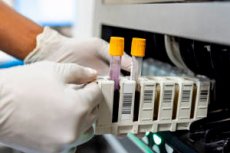用于检测中风的新型血液检验将生物标志物与临床评估相结合
Last reviewed: 02.07.2025

中风是全球范围内导致残疾的首要原因和第二大死亡原因,但及时干预可以避免严重后果。布莱根妇女医院的研究人员及其同事开展的一项新研究描述了一种新型检测方法的开发,该检测方法将血液生物标志物与临床评估相结合,以准确识别患有大血管闭塞 (LVO) 型中风的患者。
研究结果发表在《中风:血管和介入神经病学》杂志上。
“我们开发了一种革命性的、易于使用的工具,可以帮助确保更多中风患者在正确的时间在正确的地点接受关键的救命护理,”主要作者、布莱根妇女医院神经外科临床研究员、医学博士、哲学博士、公共卫生硕士 Joshua Burnstock 说道。
大多数中风是缺血性的,即脑血流受阻。左心室血栓栓塞 (LVO) 中风是一种侵袭性缺血性中风,发生在脑部主要动脉发生阻塞时。当脑部血液供应被切断时,氧气和营养物质的缺乏会导致脑细胞在几分钟内死亡。左心室血栓栓塞是严重的医疗急症,需要紧急使用机械血栓切除术(一种清除阻塞的外科手术)进行治疗。
“机械血栓切除术让那些原本可能死亡或严重残疾的中风患者得以完全康复,仿佛从未发生过中风一样,”伯恩斯托克说道。“越早进行这种干预,患者的预后就越好。这项激动人心的新技术有望让全球更多人更早地接受这种治疗。”
此前,研究小组针对了毛细血管血中发现的两种特定蛋白质:一种叫做胶质纤维酸性蛋白(GFAP),它也与脑出血和创伤性脑损伤有关;另一种叫做D-二聚体。
在这项研究中,他们表明,结合这些生物标志物的血液水平,并结合用于现场卒中分诊的FAST-ED评估,可以识别左心室缺血性卒中,同时排除脑出血等其他疾病。出血引起的症状与左心室缺血性卒中相似,因此在现场很难区分,尽管两者的治疗方法明显不同。
在这项关于诊断准确性的前瞻性观察研究中,研究人员分析了2021年5月至2022年8月期间佛罗里达州323例入院且有中风代码的患者的数据。他们发现,将GFAP和D-二聚体生物标志物水平与症状出现后六小时内的FAST-ED数据相结合,该检测能够以93%的特异性和81%的灵敏度检测出左心室出血(LVO)中风。其他发现包括,该检测排除了所有脑出血患者,这表明该技术也可用于现场检测脑出血。
Burnstock 团队也看到了这种价格实惠的诊断工具在中低收入国家(这些国家往往缺乏先进的影像技术)未来应用前景光明。它也可能有助于评估创伤性脑损伤患者。他们接下来正在进行另一项前瞻性试验,以评估该测试在救护车上使用的有效性。他们还开展了一项介入性试验,利用该技术加快中风患者的分诊,使他们能够绕过标准影像学检查,直接接受介入治疗。
“在中风治疗中,时间就是金钱,”伯恩斯托克说。“患者越快找到正确的治疗途径,预后就越好。无论是排除出血,还是确认需要干预,我们开发的技术能够在院前环境中实现这些,都将带来真正的变革。”

